Updated Electrical Machines MCQs – Efficiency and Regulation MCQs ( Electrical Machines ) MCQs
Latest Electrical Machines MCQs
By practicing these MCQs of Efficiency and Regulation MCQs ( Electrical Machines ) MCQs – Latest Competitive MCQs , an individual for exams performs better than before. This post comprising of objective questions and answers related to “Efficiency and Regulation MCQs ( Electrical Machines ) Mcqs “. As wise people believe “Perfect Practice make a Man Perfect”. It is therefore practice these mcqs of Electrical Machines to approach the success. Tab this page to check “Efficiency and Regulation MCQs ( Electrical Machines )” for the preparation of competitive mcqs, FPSC mcqs, PPSC mcqs, SPSC mcqs, KPPSC mcqs, AJKPSC mcqs, BPSC mcqs, NTS mcqs, PTS mcqs, OTS mcqs, Atomic Energy mcqs, Pak Army mcqs, Pak Navy mcqs, CTS mcqs, ETEA mcqs and others.
Electrical Machines MCQs – Efficiency and Regulation MCQs ( Electrical Machines ) MCQs
The most occurred mcqs of Efficiency and Regulation MCQs ( Electrical Machines ) in past papers. Past papers of Efficiency and Regulation MCQs ( Electrical Machines ) Mcqs. Past papers of Efficiency and Regulation MCQs ( Electrical Machines ) Mcqs . Mcqs are the necessary part of any competitive / job related exams. The Mcqs having specific numbers in any written test. It is therefore everyone have to learn / remember the related Efficiency and Regulation MCQs ( Electrical Machines ) Mcqs. The Important series of Efficiency and Regulation MCQs ( Electrical Machines ) Mcqs are given below:
Power Flow Through an Inductive Impedance – I
1. Which is the correct relation below?
a) Pim = -Pog
b) Pim = (Pog)*
c) Pim = Pog
d) Pim = -(Pog)*
Answer: a
Explanation: Electrical input to the motor is equal output power of the generator but in opposite direction.
2. The condition for maximum power output for an alternator having its load impedance as (2+j) ohms is?
a) 26.56°
b) 63.43°
c) 90°
d) 116.56°
Answer: a
Explanation: Maximum power output is arctan(1/2)= 26.56°.
3. For an alternator, the specified load angle should be _________ for an impedance angle of ‘θ’.
a) δ=θ
b) δ=90-θ
c) δ=90+θ
d) δ=-θ
Answer: a
Explanation: dP/dδ = EVcos(δ+α) = 0
δ = 90-α=θ.
4. For a 3 phase synchronous motor, the load angle should be equal to impedance angle.
a) True
b) False
Answer: a
Explanation: dP/dδ = EVcos(δ+α)/Z = 0
δ = 90-α=θ.
5. With constant E,V,Z, the maximum input power can be obtained at load angle of value _______
a) 180-θ
b) 90+θ
c) θ
d) 180
Answer: a
Explanation: dPi/dδ = EVcos(δ-α) = 0
δ = 90+α = 2α+θ=180-θ.
6. for a 3 phase 315V alternator having impedance angle of 60 degree, the required load angle for the maximum power input to the generator is _______
a) 120°
b) 60°
c) 150°
d) 30°
Answer: a
Explanation: δ = 90+α = 2α+θ=180-θ
So δ = 180-60=120°.
7. For a 3 phase synchronous generator of terminal voltage as 1 pu and field excitation of 1.2 pu. If the resistive drop is 0.2 pv, then what can be concluded for power factor?
a) upf
b) zpf
c) lagging pf
d) leading pf
Answer: a
Explanation: The Value for Ef-Ia*ra = Vt; Here it is Vt = 0. So it is upf.
8. For a 3 phase synchronous generator of terminal voltage as 1 pu and field excitation of 1 pu. If the resistive drop is 0.2 pv, then what can be concluded for power factor?
a) Leading
b) Lagging
c) Upf
d) Zpf
Answer: a
Explanation: Here Vt > Ef-Ia*ra.
9. For a 3 phase synchronous generator of terminal voltage as 1 pu and field excitation of 1.5 pu. If the resistive drop is 0.2 pv, then what can be concluded for power factor?
a) Leading
b) Lagging
c) Upf
d) Zpf
Answer: b
Explanation: Here Vt < Ef-Ia*ra.
10. For a three phase synchronous motor, if the following condition is satisfied, it can be said that it is operating at ____________
Vt < Ef-Ia*ra
a) Leading
b) Lagging
c) Upf
d) Zpf
Answer: a
Explanation: The reactive power will be positive for this condition.
11.For a three phase synchronous motor, if the following condition is satisfied, it can be said that it is operating at ____________
Vt = Ef-Ia*ra
a) Leading
b) Lagging
c) Upf
d) Zpf
Answer: c
Explanation: The net reactive power flow will be zero.
12. For a three phase synchronous motor, if the following condition is satisfied, it can be said that it is operating at ____________
Vt > Ef-Ia*ra
a) Leading
b) Lagging
c) Upf
d) Zpf
Answer: b
Explanation: The motor will absorb the reactive power which will be lagging in nature.
13. Reactive power is a matter of interest at ____________
a) output terminals of generator
b) input terminal of motor
c) output terminals of generator and input terminal of motor
d) none of the mentioned
Answer: a
Explanation: Reactive power is a matter of interest at output terminals of generator and input terminal of motor.
14. The reactive power flow is outward from an alternator, then it is ____________
a) over excited
b) under excited
c) critically excited
d) none of the mentioned
Answer: a
Explanation: Because Q > 0; For an alternator, Q = V(Ecosδ -V)/Z.
15. The reactive power flow is outward from an alternator, then the alternator works at ____________
a) lagging power factor
b) leading power factor
c) zero power factor
d) normal power factor
Answer: a
Explanation: As the reactive power is positive the power factor based on the standard convention should be lagging.
Power Flow Through an Inductive Impedance – II
1. When excitation given to a 3-phase alternator is equal to terminal voltage then ____________
a) the absorbed reactive power is zero
b) the absorbed real power is zero
c) the delivered real power is zero
d) any of the mentioned
Answer: a
Explanation: When excitation is equal to the terminal voltage there will not be any net flow of energy across the system.
2. The generator(3 phase alternator) absorbs reactive power from the infinite bus at leading power factor.
a) True
b) False
Answer: a
Explanation: Infinite bus bar provides the flux needed to set up the reactive power to produce the real power in the generator.
3. When terminal voltage exceeds the excitation, then operating power factor is?
a) leading
b) lagging
c) uPF
d) zpf
Answer: a
Explanation: As the reactive power is negative the power factor based on the standard convention should be lagging.
4. Under the conditions of maximum reactive power output, the reactive power flowing out of an alternator is __________
a) positive
b) negative
c) zero
d) equal to power
Answer: b
Explanation: The alternator will always absorb the reactive power to meet its flux requirements to generate the real power.
5. Under the condition of maximum power delivered, reactive power is __________
a) negative
b) positive
c) zero
d) same as previous condition
Answer: a
Explanation: The alternator will always absorb the reactive power to meet its flux requirements to generate the real power.
6. Under the condition for 3 phase alternator, maximum active power output, the delivered reactive power output is ________ while under maximum reactive power output, the delivered reactive power is ________
a) negative, negative
b) positive, negative
c) negative, positive
d) positive, positive
Answer: a
Explanation: Under both the situation, there is need of reactive power which will set up the flux in the machine to make it run.
7. For an overexcited 3 phase synchronous motor, connected to infinite bus is __________
a) motor is delivering reactive power to IBB
b) motor is absorbing reactive power to IBB
c) motor is delivering zero reactive power to IBB
d) none of the mentioned
Answer: a
Explanation: An over excited synchronous motor will act as a source of the reactive power.
8. If the synchronous motor connected to the infinite bus bar delivers positive reactive power to it, then it must be operating at __________
a) leading pf
b) lagging pf
c) zero pf
d) unity pf
Answer: a
Explanation: An over excited synchronous motor will act as a source of the reactive power and it will operate at leading pf.
9. For an underexcited 3 phase synchronous motor, connected to IBB is __________
a) absorbing reactive power from IBB
b) delivering reactive power to IBB
c) absorbing zero reactive power from IBB
d) delivering zero reactive power to IBB
Answer: a
Explanation: An under excited synchronous motor will act as a source of the reactive power.
10. If the synchronous motor connected to the infinite bus bar absorbs reactive power to it, then it must be operating at __________
a) leading pf
b) lagging pf
c) zero pf
d) unity pf
Answer: b
Explanation: An under excited synchronous motor will act as a sink of the reactive power and it will operate at leading pf.
11. What is Synchronous motor?
a) absorbs reactive power for maximum input real power
b) absorbs reactive power for maximum input reactive power
c) delivers reactive power for maximum input real power
d) delivers reactive power for maximum input reactive power
Answer: a
Explanation: Synchronous motor always absorbs reactive power for maximum real as well as reactive power.
12. Under the conditions of maximum values of active or reactive power, a synchronous machine always absorbs reactive power.
a) True
b) False
Answer: a
Explanation: Synchronous motor always absorbs reactive power for maximum real as well as reactive power.
13. An ________ synchronous machine delivers reactive power whereas an ________ one absorbs reactive power.
a) over excited, under excited
b) under excited, over excited
c) over excited, over excited
d) under excited, normal excited
Answer: a
Explanation: An over excited synchronous machine delivers reactive power whereas an under excited one absorbs reactive power.
14. An alternator, with synchronous reactance of 0.8 pv is connected to an IBB at rated voltage. With its excitation emf adjusted to 1.3 pv, the alternator delivers an output of 0.5 pv. The load angle is __________
a) 17.92
b) 72.08
c) 34.92
d) 90
Answer: a
Explanation: δ = atan(0.5*0.8/1.3) = 17.92°.
15. An 3 phase alternator star connected 400 V synchronous motor takes a power input of 5472 watts at rated voltage. Its synchronous reactance is 10** per phase and negligible resistance. If its excitation voltage is adjusted equal to the rated voltage of 400 V, its power factor is _______
a) cos(10°)
b) cos(20°)
c) cos(40°)
d) cos(30°)
Answer: a
Explanation: Vt = Ef = 400/1.73 = 231 V
V*Esinδ/X = P
δ = 20°
θ = δ/2.
Efficiency of Synchronous Machines
1. The short circuit load losses is/are ______________
a) direct load loss and stray load losses
b) direct load loss
c) stray load losses
d) field current loss
Answer: a
Explanation: Short circuit losses comprise of direct load loss and stray losses too.
2. The open circuit voltage and open circuit core loss variation is?
a) 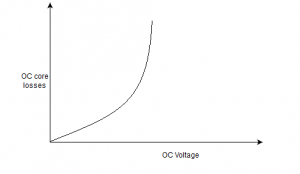
b) 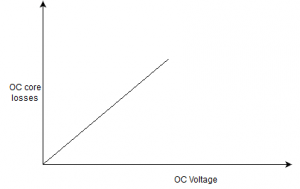
c) 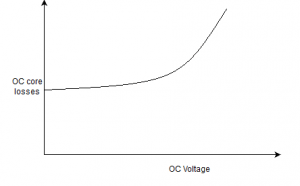
d) 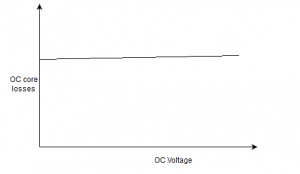
Answer: a
Explanation: Core losses vary as a square of the voltage.
3. Rotational losses vary as following with respect to field current.
a) 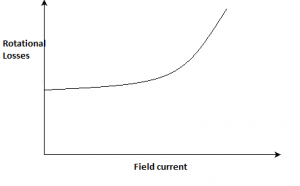
b) 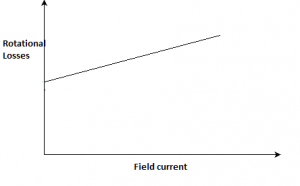
c) 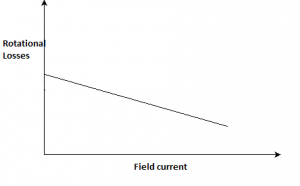
d) 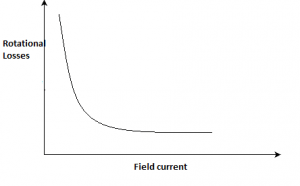
Answer: a
Explanation: The y-intercept depicts the friction and windage losses.
4. A 100 KVA, 400V, 3-phase, star connected alternator due to the following data:
Friction and windage losses = 340W
Open circuit core loss = 480W
Rf = 180ohms, ra = 0.02ohms.
The voltage applied to the field winding is 220V. The short circuit load loss at half full load is?
a) 258W
b) 268W
c) 480w
d) 340W
Answer: a
Explanation: SC losses at half load = 3*((Ia/2)2)*ra
= 3*((131.22/2)2)*0.02
= 258.3 A.
5. A 100 KVA, 400V, 3-phase, star connected alternator due to following data:
Friction and windage losses = 340W
Open circuit core loss = 480W
Rf = 180ohms, ra = 0.02ohms.
The voltage applied to the field winding is 220V. The field current
loss will be?
a) 270W
b) 258W
c) 480W
d) 250W
Answer: a
Explanation: Field circuit loss = 220^2/180 = 169W
6. A 100 KVA, 400V, 3-phase, star connected alternator due to following data:
Friction and windage losses = 340W
Open circuit core loss = 480W
Rf = 180ohms, ra = 0.02ohms.
The voltage applied to the field winding is 220V. The efficiency of the machine at half load is?
a) 96.7%
b) 95%
c) 94.2%
d) 97
Answer: a
Explanation: Total losses at half load = 340+480+258+268.9 = 1347W
Efficiency = 1-(1347/40000+1347)
= 96.47%.
7. A 100 KVA, 400V, 3-phase, star connected alternator due to following data:
Friction and windage losses = 340W
Open circuit core loss = 480W
Rf = 180ohms, ra = 0.02ohms.
The voltage applied to the field winding is 220V. The load losses at full load is?
a) 1033W
b) 500W
c) 540W
d) 940W
Answer: a
Explanation: Short circuit losses at full load = 3*(131.22)2*0.02 = 1033W.
8. A 100 KVA, 400V, 3-phase, star connected alternator due to following data
Friction and windage losses = 340W
Open circuit core loss = 480W
Rf = 180ohms, ra = 0.02ohms.
The voltage applied to the field winding is 220V. Efficiency at full
load is?
a) 97%
b) 96.5%
c) 92%
d) 95%
Answer: a
Explanation: Total losses at full load = 340+480+1033+268.9 = 2122W
Efficiency = 1 – (2122/2122+80000) = 97.4%.
9. The given variable losses are 5kW fr a 500 KVA, 11 kV, 3-phase star connected alternator having armature resistance of 4 ohms. Calculate the current at which maximum efficiency occurs?
a) 20.4A
b) 10.2A
c) 40A
d) 26A
Answer: a
Explanation: I2=5000/3*4
I = 20.4 A.
10. The given variable losses are 5kW fr a 500 KVA, 11 kV, 3-phase star connected alternator having armature resistance of 4 ohms. Calculate the full load armature current per phase.
a) 26.24 A
b) 20.41 A
c) 79 A
d) 40 A
Answer: a
Explanation: I = P/1.73*V = 5000/1.73*11000 = 26.24 A.
11. A synchronous machine with its field winding on stator and polyphase armature winding on rotor. At steady state, its air gap field is?
I. stationary w.r.t. stator
II. rotating at double the speed Ns w.r.t. rotor
III. rotating in direction opposite to rotor
a) I, II, III
b) I
c) II, III
d) II, I
Answer: a
Explanation: All the statements are correct.
12. A synchronous machine with its field winding on rotor and polyphase armature winding on stator. At steady state running condition, its air gap field is?
a) rotating at synchronous speed w.r.t. stator
b) stationary w.r.t. rotor
c) rotating in the direction of the rotor rotor rotation
d) all of the mentioned
Answer: a
Explanation: As the field is on the rotor, the field will be set up w.r.t. rotor.
13. Consider a 3-phase cylindrical-rotor alternator.
A. E.m.f. generated by armature reaction lags armature current by
90°.
B. Air gap voltage leads the field flux by 90°
C. Air gap voltage lags the field flux by 90°
D. Armature reaction mmf lags the field flux by (90°+ internal p.f. angle)
a) A, B, D
b) A, C, D
C) B, D
D) C, D
Answer: a
Explanation: Air gap voltage will lag the field flux by 90° to generate the emf.
14. In a 3-phase cylindrical-rotor alternator, synchronous reactance is sum of _____________
a) mutual and leakage reactance
b) magnetizing and leakage reactance
c) magnetizing and mutual reactance
d) mutual, magnetizing and leakage reactance
Answer: a
Explanation: Xs = magnetizing reactance + leakage reactance.
15. The reactive power output of a synchronous generator is limited by _________
a) armature current and field current
b) field current and load angle
c) load angle and excitation
d) armature current only
Answer: a
Explanation: Q=f(Ia,If).
Losses and Efficiency
1. For the given traction application using a dc series motor for a starting time ’t’ is applied. If this method is replaced by a series-parallel control, giving 50% time for each series and parallel. The saving in the starting energy of _________
a) 25%
b) zero
c) 50%
d) 75%
Answer: a
Explanation: Initially let the energy utilized was 100% for time t.Then for 50% duration for series, energy used is 50%. For parallel operation for the same circuit, the resistance gets halved assuming the same machine. So, for 50% of the parallel operation, 25% of energy is only utilized. Hence total saving is 25%.
2. If two series motors are identically coupled. One is running as motor while other as generator. For this combination, the iron losses and frictional losses are found identical for _________
a) identical speed and excitation
b) identical speed
c) identical rating and construction
d) none of the mentioned
Answer: a
Explanation: For same iron and frictional losses, same frequency should be there. For that same speed must be run.
3. Hysteresis loss in a dc machine is _____ of rate of flow of air and _____ on frequency of _____
a) independent, dependent, magnetic reversal
b) independent, dependent, operation
c) dependent, independent, magnetic reversal
d) none of the mentioned
Answer: a
Explanation: Hysteresis loss in a dc machine is independent of rate of flow of air and depends on frequency of magnetic reversal.
4. In dc machine iron losses cause _________
a) heating in core
b) loss in efficiency
c) rise in temperature of ventilating air
d) all of the mentioned
Answer: a
Explanation: The iron losses cause heating of the core which causes reduction inefficiency and cooling air gets heated up.
5. For squirrel cage and slip ring induction motor, cooling methods is efficient in _________
a) squirrel cage induction motor
b) slip ring induction motor
c) both of the motors
d) none of the mentioned
Answer: a
Explanation: As the squirrel cage induction motor has more ventilation and more space as compares to slip ring induction motor, there will be more efficient ways to cool down the squirrel cage motor.
6. If one of the phases of the supply breaks down, then the connected three phase induction motor _________
a) continues to run as a single phase induction motor, provided load does does not increase beyond 57.7%
b) stops operating after few seconds
c) continues to run as single phase induction motor
d) continues to run as two phase induction motor
Answer: a
Explanation: When one of the phases breaks down then the other two phases will supply the rated current but the load should be reduced to 57.7%.
7. If one of the phases of RYB supply gets broken, then the temperature rise of the induction motor _________
a) remains same as before
b) reduces as compared to the normal operating temperature
c) reduces to temperature rise of corresponding single phase induction motor
d) increases
Answer: a
Explanation: The current flowing in the armature will remain same so to maintain the flux requirements of the machine. Hence the temperature rise will also remain same as the current remains same.
8. A three phase induction motor is connected to the infinite bus operating at the normal conditions. There occurs an unbalancing in the supply, leading to _________
a) unequal heating losses
b) stopping of motor
c) increase in lower
d) none of the mentioned
Answer: a
Explanation: The unbalancing in the supply phase will create an unbalanced distribution of the current in the phases, thereby unequal heating.
9. A peaky voltage supply is given to the 3 phase power transformer of the connection power system. These results in _________
a) reduction in iron losses
b) reduction in copper losses
c) increase in iron losses
d) reduction in noise
Answer: a
Explanation: The flux wave will be sinusoidal in nature as the emf is peaky in nature. Sine wave has least losses when compared to other wave forms.
10. The iron losses in a saturated three phase alternator is lesser than the non-saturated three phase alternator.
a) True
b) False
Answer: a
Explanation: The non-saturated reactance is greater than saturated reactance. So the reactive losses or iron losses will reduce due lesser contribution of the same.
11. The hydroelectric plants in the industry are best suited with _________
a) closed circuit air cooling
b) hydrogen gas
c) direct water
d) all of the mentioned
Answer: a
Explanation: The closed circuit is so used to reuse the air in the system so that to save water again in the cooling system.
Updated Electrical Machines MCQs – Efficiency and Regulation MCQs ( Electrical Machines ) MCQs
